Rajasthan Board RBSE Class 12 Biology Notes Chapter 7 Transpiration
Introduction
- Plants absorb large amount of water from soil by roots. Only a small amount of water absorbed is used by plants. The remaining water is lost to atmosphere by the aerial parts of plant in the form of water vapour.
- This loss of water from the aerial parts of plant body in the form of water vapour is called transpiration.
- Transpiration is a physiological process. The loss occurs through special structures present as minute pores in plant called as stomata.
- Under some conditions 90-99% of water absorbed by plants is lost to atmosphere in the form of water vapour.
Types of Transpiration
Depending upon the structure involved, transpiration can be of three types :
(i) Stomatal transpiration : Stomata are minute openings found in the epidermis of leaves and on herbaceous stems. About 90-97% of total water, absorbed by plants is lost through these openings.
(ii) Cuticular transpiration : A waxy coating found on the surface of outer wall of epidermal cells of aerial parts of plants is called cuticle.
- When loss of water occurs from the surface of leaves and herbaceous stem by direct evaporation from the epidermal cells through cuticle, the process is called cuticular transpiration.
- The amount of water lost through cuticle is very low and varies with the thickness of cuticle and accounts only 3 to 10% of the total water loss.
- In xerophytes, a very thick cuticle is found as an adaptation to reduce cuticular transpiration.
- Transpiration from the surface of herbaceous stems, fruits and floral parts is mostly cuticular. Cuticular transpiration takes place continuously during day and night.
![]()
(iii) Lenticular transpiration : Lenticels are the minute areas found in the bark of woody stem and the fruits. These are filled with loosely arranged cells known as complementary cells.
- Loss of water from lenticels is called lenticular transpiration.
- Lenticular transpiration is negligible and accounts for only
StomataI Transpiration
- It takes place through stomata.
- In order to understand the mechanism of stomatal transpiration it is necessary to learn about the structure of stomata and the anatomy of leaves.
- The upper and lower surface of leaves form the epidermal layer.
- Between the two epidermal layers is found mesophyll tissue.
- In dorsiventral leaves, the mesophyll is differentiated in to palisade and spongy tissue where as in the isobilateral leaves, mesophyll is composed of only spongy tissue.
- Stomata may be found on both the surfaces (isobilateral leaves) or only on one surface (dorsiventral leaves).
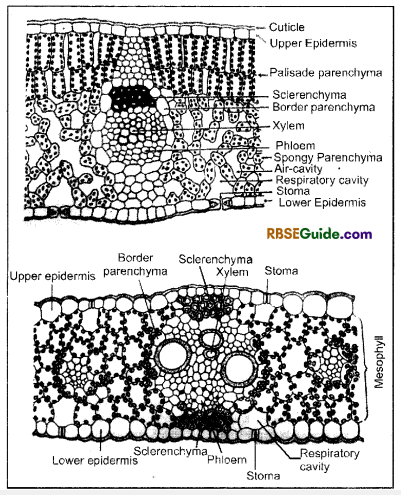
On the basis of presence of stomata in the epidermis, the leaves may be mainly of three types.
(i) Hypostomatic leaf : When stomata are found only on the lower epidermis, and no or very few stomata are found on upper epidermis, the leaf is called hvpostomatic.
Ex. Apple, Potato, most dicots.
(ii) Amphistomatic leaf: When stomata are found in more or less equal number on both the epidermis of leaf, it is called amphistomatic leaf.
Ex. Oat, Maize and most monocots.
(iii) Epistoniatic leaf: When stomata are found only on the upper epidermis, the leaf is called epistomatic
ex. Water lily and other floating hydrophytes.
![]()
Structure of Stomata
1. Stoma are minute openings found in the epidennis of leaves and also green stems.
2. Each stomatal opening is surrounded by two specialized epidermal cells, called guard cells.
3. The guard cells are more or less kidney shaped in most plants. They have nucleus, ehloroplasts and other cytoplasmic contents.
4. The inner wall of guard cells surrounding the pore is thick and rigid where as the outer wall is thin and elastic.
5. In some cases subsidiary cells are found around the guard cells. These are a little different from rest of the epidermal cells.
6. The stomatal pore is open when guard cells are in turgid state and the pore is closed when the guard cells become flaccid.
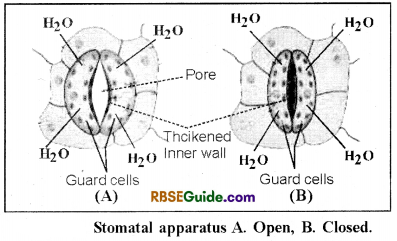
7. During turgid state of guard cells. the outer thin and elastic walls of guard cells strech outwards.
8. This is results into outward pulling of thick and rigid non elastic inner walls which become concave causing opening of stomata.
9. When the guard cells become flaccid the inner thick and Ñtid (inelastic) walls become straitht and the pece is closed.
10. The number of stomata in leaves may be in the range of 100-60,000 per square centimeter.
Mechanism of Opening and Closing of Stomata
- Opening and closing ol stomata ma be called stomatal movement.
- Several hypothesis have been proposed to explain stomatal movement.
![]()
1. Starch : Sugar hypothesis : This hypothesis was proposed by J.D. Sayre (1923)
- Prior to Sayre, Lloyd (1908) showed presence of starch in the guard cells.
- According to starch-sugar hypothesis during day time, CO2 is used in guards cells in photosynthesis and pH of guard cells increases (7.0).
- At this pH, phosphorylase enzyme becomes active in guard cells and starch is converted into glucose-1-phosphate.
- On account of this, DPD of guard cells increases and they become turgid due to endosmosis and stomata open.
- During night, photosynthesis stops and CO2 accumulates in the guard cells, due to which the pH of guard cells decreases (5.0).
- At this pH glucose-1-phosphate converts into starch.
- DPD of guard cells decreases and they become flaccid due to exosmosis, causing closing of stamata.
.
2. Steward’s hypothesis :
- According to this hypothesis, increase in pH of guard cells results into conversion of starch in glucose-1 phosphate, and then into glucose-6-phosphate which finally converts in to glucose.
- Glucose and glueose-6-phosphate are more soluble in water as compared to glucose-1-phosphate.
- This results into increase, in the osmotic concentration of guard cells leading to opening of stomata.
Biochemical reactions during day time :
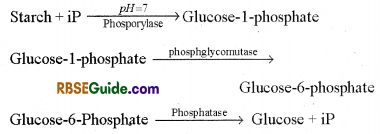
Biochemical reactions during night

Active Potassium Ion Transport theory:
1. This theory was proposed by Japanese scientists Jmamura and Fujino (1959) and was modified by Levitt (1974).
2. Presently this is the most accepted theory for explaining stomatal movement.
3. According to this theory, during presence of light malic acid is formed in guard cells which breaks into malate and hydrogen ion (H+).
![]()
4. These H+ move out of guard cells and pass to subsidiary cells (infflux) or epidermal cells.
5. K+ from subsidiary cells or epidermal cells move into guard cells where they react with the malate and form potassium malate.
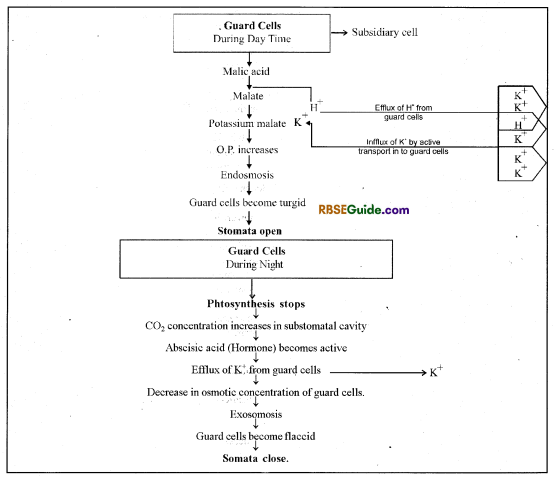
6. This increases osmotic concentration of the guard cells. Increase in osmotic concentration of guard cells results into endosmosis in these cells and they become turgid causing opening of stomata.
7. During night efflux of K+ from guard cells to adjacent epidermal cells takes place.
8. H+ flow from epidermal cells in to guards cells where they react with malate to form malic acid.
9. This principle is also called as K+ion exchange or anion exchange or photo active proton transport theory.
10. At present this theory is most accepted theory for explaining opening and closing of stomata.
Factors affecting rate of Transpiration
The factors affecting rate of transpiration can be divided in to two parts.
1. External factors (Atmospheric factors)
(i) Light: Light affects transpiration both directly as well as indirectly.
- Presence of light directly affects opening of stomata and indirectly it causes rise in temperature resulting into increase in rate of transpiration.
- Absence of light results in to closing of stomata and decrease in temperature hence reduces rate of transpiration.
(ii) Wind : Increase in wind velocity quickly replaces humid air from the surrounding of leaves by dry air thus rate of transpiration increases in fast blowing winds.
![]()
(iii) Available soil water : When available soil water decreases rate of transpiration also decreases but up to a certain limit.
(iv) Temperature : Increase in temperature reduces relative humidity of atmosphere. This reults in to increase in rate of transpiration.
(v) Atmospheric pressure : Reduction in atmospheric pressure causes increase in rate of transpiration.
(vi) Humidity : Increase in humidity in the atmosphere reduces rate of transpiration where as when atmospheric humidity decreases, rate of transpiration increases.
2. Internal factors (Plant factors)
(i) Leaf structure : Rate of transpiration is affected greatly by structure of leaf.
- Presence of sunken stomata and thick cuticle, waxy coating, and covering of hairs on leaf surface reduces rate of transpiration.
- The number of stomata per unit area of the leaf is also an important factor. Greater is the number of stomata, higher is the rate of transpiration.
(ii) Leaf orientation : When leaves are oriented at right angle of sunlight, rate of transpiration is high.
(iii) Root shoot ratio : Higher is root shoot ratio higher is the rate of transpiration.
Significance of Transpiration
- Transpiration is both beneficial as well as harmful for plants.
- According to some scientists transpiration is a necessary evil for plants or unavoidable evil for plants.
Beneficial aspects.
- Ascent of sap depends on transpiration pull.
- Transpiration creates a situation of shortage of water in plant and so the plant absorbs large amount of water along with minerals.
- Transpiration cools down the plant and thus prevents solarization.
- Excess of water is removed out by transpiration.
- No plant growing on soil can survive without transpiration. Hence it is necessary for plants.
![]()
Harmful aspects.
- Rate of transpiration is related to rate of absorption by roots up to a certain limit.
- When available soil water decreases, resulting into reduced absorption, transpiration may result in to temporarywilting and may lead to permanent wilting causing death of the plant.
- Innumerable plants die every year due to wilting caused by excessive transpiration. Hence it acts as an evil for plants.
Guttation
1. De Barry (1869) first observed this process.
2. Exudation of droplets of water from the tips and margins of leaves is called guttation.
3. This loss occurs through minute openings found at the terminal ends of the veins of leaves of some plants. These openings are called hydathodes.
4. The pore of hydathode is called water pore and is a incompletely differentiated stoma.
5. These are permanently open pores because the two cells surrounding the pore are incapable of movement.
6. As shown in fig. 7.3 B, a group of thin walled loosely arranged parenchyma cells is present below’ the hydathode. This is called epithem.
7. The Each Vary elements of veins terminate or end just close to the epithem tissue.
8. When water absorbed by roots exceeds transpiration, root pressure develops and water from xylem vessels and tracheids is pushed in the epithem tissue.
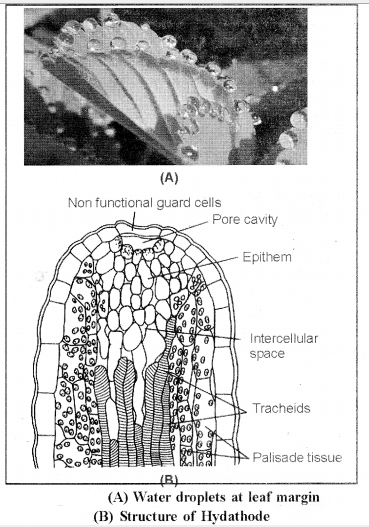
9. Finally water is exuded out in the form of droplets through the pore. Thus guttation is expression of root pressure.
10. Guttation takes place more during night and early morning hours. Ex. Tomato, grasses. Potato, Bryophyllum, Colocasia etc.
![]()
11. The fluid lost in guttation is not pure water, but contains dissolved minerals and some organic substances also.
12. Deposition of minerals and organic substances on the surface of leaves may result in to injurious effect and may provide a medium for pathogenic attack.
Bleeding
- Exudation of xylem sap front injured or cut end of the plant part is called bleeding.
- This is due to the positive pressure developed on the xylem sap due to root pressure.
- When the xylem vessels are cut or become injured, the sap flows out from the cut ends.
- Bleeding occurs when cuts are made in certain tissues of some plants.
- A milky sap called latex is secreted in the laticiferous ducts in cortex, and pith as well as in secondary tissues. Example : Rubber, Poppy.
- When stems of Palms, Yuccas and Agaves are cut, bleeding of phloem sap occurs. This may contain upto 29° 6 sugar.
